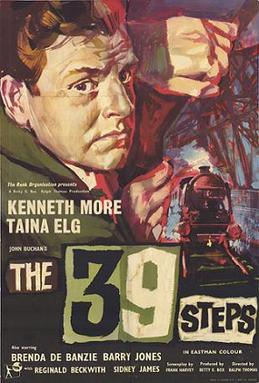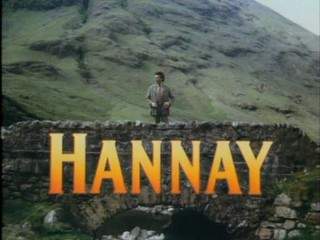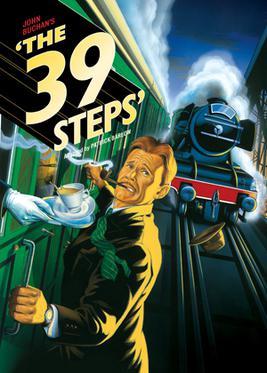
Robert Powell is a British actor who is known for the title roles in Mahler (1974) and Jesus of Nazareth (1977), and for his portrayal of secret agent Richard Hannay in The Thirty Nine Steps (1978) and its subsequent spinoff television series. Other major screen roles have included Tobias "Toby" Wren in the BBC science-fiction programme Doomwatch (1970), David Briggs in the sitcom The Detectives (1993–1997) alongside Jasper Carrott, and Mark Williams in the medical drama Holby City (2005–2011).

Greenmantle is the second of five novels by John Buchan featuring the character Richard Hannay. It was first published in 1916 by Hodder & Stoughton, London. It is one of two Hannay novels set during the First World War, the other being Mr Standfast (1919); Hannay's first and best-known adventure, The Thirty-Nine Steps (1915), is set in the period immediately preceding the war.
Major-General Sir Richard Hannay, KCB, OBE, DSO, is a fictional character created by Scottish novelist John Buchan and further made popular by the 1935 Alfred Hitchcock film The 39 Steps, very loosely based on Buchan's 1915 novel of the same name. In his autobiography, Memory Hold-the-Door, Buchan suggests that the character is based, in part, on Edmund Ironside, from Edinburgh, a spy during the Second Boer War, and a British Army field marshal and CIGS.

Mr Standfast is the third of five Richard Hannay novels by John Buchan, first published in 1919 by Hodder & Stoughton, London.

Bert Coules is an English writer, mainly for the BBC, who has produced a number of dramatisations and original works. He works mainly in radio drama but also writes for TV and the stage.
David Robb is a Scottish actor.

The Three Hostages is the fourth of five Richard Hannay novels by the Scottish author John Buchan, first published in 1924 by Hodder & Stoughton, London.

The following is a partial list of unproduced Alfred Hitchcock projects, in roughly chronological order. During a career that spanned more than half a century, Alfred Hitchcock directed over fifty films, and worked on a number of others which never made it beyond the pre-production stage.

Jamaica Inn is a novel by the English writer Daphne du Maurier, first published in 1936. It was later made into a film, also called Jamaica Inn, directed by Alfred Hitchcock. It is a period piece set in Cornwall around 1815. It was inspired by du Maurier's 1930 stay at the real Jamaica Inn, which still exists as a pub in the middle of Bodmin Moor.

The 39 Steps is a 1935 British spy thriller film directed by Alfred Hitchcock, starring Robert Donat and Madeleine Carroll. It is loosely based on the 1915 novel The Thirty-Nine Steps by John Buchan. It concerns a Canadian civilian in London, Richard Hannay, who becomes caught up in preventing an organisation of spies called "The 39 Steps" from stealing British military secrets. Mistakenly accused of the murder of a counter-espionage agent, Hannay goes on the run to Scotland and becomes tangled up with an attractive woman, Pamela, while hoping to stop the spy ring and clear his name.

The 39 Steps is a 1959 British thriller film directed by Ralph Thomas and starring Kenneth More and Taina Elg. Produced by Betty Box, it is a remake of the 1935 Alfred Hitchcock film, loosely based on the 1915 novel The Thirty-Nine Steps by John Buchan.

The Thirty Nine Steps [sic] is a British 1978 thriller film directed by Don Sharp, with screenplay by British playwright Michael Robson, based on the novel The Thirty-Nine Steps by John Buchan. It was the third film version of the 1915 novel.
Evan George Patrick Barlow is an English actor, comedian and playwright. His comedic alter ego, Desmond Olivier Dingle, is the founder, artistic director and chief executive of the two-man National Theatre of Brent, which has performed on stage, on television and on radio. Barlow was born in Leicester.

Hannay was a 1988 ITV television series, a prequel spin-off from the 1978 film version of John Buchan's 1915 novel The Thirty-Nine Steps. The film and series starred Robert Powell as Richard Hannay in the post Second Boer War years.
Peter Pienaar is a character from John Buchan's series of Richard Hannay books. He is described by Hannay as being "five foot ten, very thin and active, and as strong as a buffalo [with] pale blue eyes, a face as gentle as a girl's, and a soft sleepy voice."

The 39 Steps is a parody play adapted from the 1915 novel by John Buchan and the 1935 film by Alfred Hitchcock. The original concept and production of a four-actor version of the story was written by Simon Corble and Nobby Dimon, and premiered in 1996. Patrick Barlow rewrote this adaptation in 2005.
John Scantlebury Blenkiron is a fictional character who appears in several books by John Buchan, including Greenmantle, Mr Standfast, The Courts of the Morning and Sick Heart River. Blenkiron comes from the United States, and has assisted Richard Hannay. When Hannay first meets Blenkiron, it is revealed that he suffers from dyspepsia and so often drinks boiled milk, eats dry toast and fish. Subsequently he has an operation where a part of his duodenum is replaced by rubber tubing and his digestion is restored.

The 39 Steps is a 2008 British television adventure thriller feature-length adaptation of the 1915 John Buchan novel The Thirty-Nine Steps produced by the BBC. It was written by Lizzie Mickery, directed by James Hawes, and filmed on location in Scotland, starring Rupert Penry-Jones, Lydia Leonard, David Haig, Eddie Marsan, and Patrick Malahide. Following three screen versions of the novel and the 1952 and 1977 television adaptations of The Three Hostages, Penry-Jones became the sixth actor to portray Hannay on screen. This adaptation is set on the eve of the First World War and sees mining engineer Richard Hannay caught up in an espionage conspiracy following the death of a British spy in his flat.
The Three Hostages was a British television series which aired on the BBC in 1952. It was an adaptation of the 1924 novel The Three Hostages by John Buchan featuring his character Richard Hannay who is played by Patrick Barr. It consisted of six 30 minutes episodes. The BBC adapted the story again in 1977 as a film The Three Hostages with Barry Foster as Hannay. Broadcast live before telerecording was utilised in the UK, the series is missing, believed lost.
A romantic thriller is a narrative that involves elements of the romance and thriller genres. A good thriller provides entertainment by making viewers uncomfortable with moments of suspense, or the heightened feeling of anxiety and fright. A thriller is more a familiar concept and description than a pure genre. A typical genre can vary from comedy and melodrama to adventure and romance. All thrillers are a combination of different genres. The basic thriller trait of suspense fits with some genres better than others. For example, crime, sci-fi and romance allow more scope for suspense than Screwball Comedies or musicals do.














